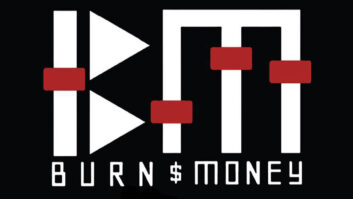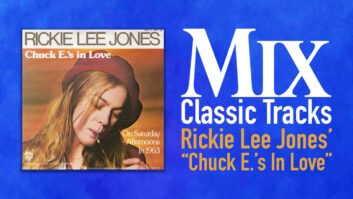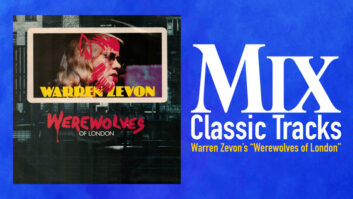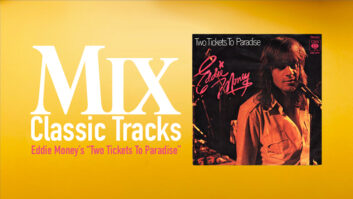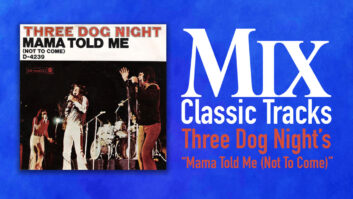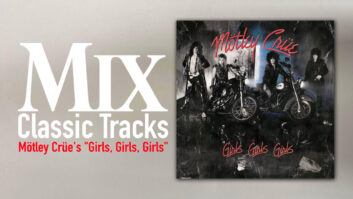What’s that sound? Is that flap-flap-flap you’re hearing the sound of money flying out your window on little white wings? Is that VROOM outside in the street the roaring engine of the moving van that’s taking your job to India or your hopes and dreams to Nowheresville? Are all the pens in that cup on your desk filled only with red ink? Did you think because you were smart enough not to invest in a dotcom during the go-go ’90s that you’d be home-free in the new millennium? In the immortal words of Fred Willard’s hapless, washed up Mike LaFontaine character in A Mighty Wind, “Wha happen?!”
It seems that everywhere you look in the entertainment industry, people are singing the blues: about revenue lost to piracy, or changing business models, or “unfair” competition from foreign companies, or a general downturn in the economy, or the post-9/11 blahs — you name it. It’s hard not to buy into the skepticism and despair because we see it all around us in our daily lives: businesses going bust, friends out of work, that nagging feeling of desperation creeping in when you least expect it. Hell, three years ago, we devoted our entire May issue trying to answer the question: Can the music industry be saved?
The answer, of course, is “Yes,” but we all have to change the way we do business because the old models are breaking down and being replaced by new ones. The big questions then become: How can I get some of the action? How can I anticipate what’s coming next? Can I take the skills I have today and use them for the jobs of tomorrow? Where is the money?
“Oh, it’s out there, Jerry!” Kramer might say with that wild but confident swagger. And it is. Yes, there has been a downturn in the conventional music industry because of file sharing. Yes, theater revenues for Hollywood films were down a couple of percentage points in 2005 — blame high ticket prices, weak movies and the rising popularity of DVDs for that. And, yes, recording studios are still closing left and right. But there are still billions and billions of dollars being generated in the entertainment business, and there are many, many people who are getting rich because of it — you just don’t happen to know who they are because it’s new people doing different things.
For instance, did you know that the ringtone industry generated more than $600 million in sales in 2005 — double what it made in 2004? That’s a revenue stream for artists, labels and the companies that market them that literally did not exist five years ago. And there are plenty of examples like that up and down the industry.
That’s what this issue is all about: Re-evaluating the old business paradigms, learning how to look for new opportunities, seeing how our colleagues are dealing with such a challenging fiscal landscape, helping you figure out how you might fit into the ever-shifting scheme of things. This is really just a fancy way of saying: “Get over it, because it isn’t ever going to change back to the way things were; deal with the reality of how things are, not what you wish they were; and look outside the world you’ve built and take some chances.” We don’t mean to be harsh; we’re just trying to keep it real.
Many of the articles in this issue discuss different aspects of this dilemma/opportunity, but I’d like to kick things off with a broad overview on the subject — and offer a few tips, as well.
Here are two words you need to know to be savvy in this business: mobile apps. There are still a few of us troglodytes out there who use our cell phones only as cell phones (when we remember to carry them at all), and who still use a stock ringtone. But that is so 2002. Today’s (and tomorrow’s) cell phones are designed to be media centers, providing audio and video entertainment, text messaging, Internet access and other things we haven’t even thought of yet. Let’s face it, the iPod has drastically changed the fortunes of the music industry. It turns out that a lot of people will pay for music legally, so now the scramble has begun by content providers — Apple and many others — to sew up as many labels and acts as they can to give their potential customers as much choice as possible. Companies are suddenly trying to outbid each other to land exclusive content that will give them an edge over the competition — that’s great for the artists — but the mix of corporations involved goes beyond the major record labels. Suddenly, Verizon, for example, is spending big bucks promoting an exclusive audio/video/ringtone download for a song called “Hips Don’t Lie” by Shakira (whose hips truly do not lie) and Wyclef Jean. Everyone from the ubiquitous Black Eyed Peas to Moby to the Rolling Stones has cut a big-money deal to offer exclusives with Apple or other companies, but some of the profits have also trickled down to smaller bands.
Have you ever paid to listen to a podcast? Not many people have. So far, podcasts have mostly been a free service to increase traffic to Websites — most of which are still trying to make their nut by selling advertising. This used to be a pretty tough proposition, but it’s getting easier as print advertising declines (sniff, sniff…that’s okay…we’ll be fine). Using the model of iTunes’ success, companies (and individuals) are finding that people will pay a buck or three for regular podcasts. For instance, the brilliant British comedian Ricky Gervais (The Office, Extras) has a successful pay podcast, and there are business sites that offer pay podcasts of wisdom from business leaders and writers, as well as tips and advice. And though most podcasts are still extremely low-budget affairs that do not require an audio engineer, just wait — as more and more people show their willingness to pay for cool content, production values will go up. There will be theme music, sound effects and multiple-mic setups, and someone is going to get that work. Eventually, there will be companies that specialize in podcast production.
Video and audio-for-video are two more growth areas, even though it seems like MTV hasn’t shown a video in, what, 15 years? There are more outlets than ever showing music videos; go to www.rollingstone.com and you’ll see links for hot videos (as well as its own “exclusives”). In fact, go to almost any entertainment or even hard-news site (www.cnn.com, et al) and you’re a mouse-click away from watching a hit video. Video budgets are not what they once were, except for the biggest acts, but a wider range of artists are getting to make videos. And despite the fact that most are still lip-synched, the majority also require production audio — it’s a nice way for recordists to scare up a day or two of work. Beyond those sorts of conventional videos, however, there’s been an explosion of performance videos, both for the long-form DVD market and, just as significant, for the value-added bonus material sometimes attached to regular audio albums. Record companies still want to do whatever they can to maximize the sales of CDs because they make more on them than they do on downloads. (So do the artists.) And that’s why now it’s so common to find some sort of DVD included with the album package (even if it’s just a single video/song); that’s also why the difficult-to-pirate DualDisc seems to be catching on in a big way.
The demand for concert material has even helped the troubled mobile recording industry, though frankly more and more people are turning to smaller operations that come into a venue with a few good mics and a DAW loaded with processing plug-ins rather than a truck with a fantastic console and all the outboard gear you could want. These are good times for companies that offer inexpensive remote-recording services. It’s a tough field in which to establish a reputation, but the aggressive and well-connected operations are getting work. Smart recording studios are figuring out ways to lure some of these midline and cheaper projects to their big rooms for mixing and post. It’s never been more vital for studios to keep an ear to the ground to know who’s working on what, and where, because piecemeal work is increasingly the bread-and-butter of the big studios; the days of long lockouts are long gone, except in the rarest cases.
The growth of DVD/DualDiscs has also been the saving grace of the highly hyped surround recording/mixing market. Despite glowing press and the best intentions and brave expenditures of a few record labels, surround CDs have not caught on. Now, the top mixers are finding that surround album work is already drying up — and before the format wars even got settled! But this is no time to ditch that surround system because the rest of the industry is embracing surround: HDTV, DVD, film and — the great sleeper you should all be thinking about — video games! Whether you have a home studio or a commercial facility, surround should be part of the equation. If there’s no call for it in your business now, there will be soon. And it’s never been easier and less expensive to get in the game. Surround may well become many mixers’ ticket out of their niche and into different income-producing fields.
Videogames. Maybe you have kids who have an Xbox or PS2 going 24/7. Or maybe you’re playing Madden football or Grand Theft Auto: San Andreas in your spare time. In the past week alone, my 15-year-old son bought a $50 RPG game called The Elder Scrolls IV: Oblivion, and my 12-year-old-daughter downloaded a demo of some cool game that’s coming out in a couple of months; I can’t recall the title. I hear the music for The Sims wafting through my house more often than I hear the family hi-fi. Dig this: In 2005, gaming retailers sold more than $10.5 billion worth of gaming hardware, software and accessories. The demographics of who’s playing games broadens with each passing year; once the province mostly of teen boys (okay, it still is), it is also increasingly attracting girls and people over 30. If you’ve seen (and heard) the best of the current generation of games, you know that is an industry that is rapidly maturing and it is already proving to be a great source of jobs for audio engineers, sound designers, composers, programmers and, of course, visual artists. With budgets for big games now well into the millions, there’s money to be made by people with the right talents.
Recently, I spoke with Jeanine Cowen, who’s both a teacher at the Berklee College of Music and director of the Recording Arts program at the Center for Digital Imaging Arts, a new school opening at Boston University this month. She notes, “What I’ve seen the last few years is that a lot of the jobs that graduates are getting are in non-traditional — that is to say ‘regular music industry’ — fields. There’s a lot of game work out there, and there’s a huge need for qualified people.
“[At CDIA], we still teach traditional music industry production engineering, but we also have a focus on game audio and film post-production. Today, I feel there’s more audio work in games than in the film world. CDIA also has a film and animation program, so we even have visual collaborators for our recording arts students.
“It is important to know the audio basics, however,” she stresses. “Even though we’re so far into the digital world, there are still as many signal flow issues in digital as there are in analog, and we still have to deal with the acoustic world and with microphones and loudspeakers that are part of the chain. Of course, computers are a huge part of so much music recording now, and, obviously, they’re extremely important when it comes to games, so in a sense, today’s student has to learn much more than I did when I went to Berklee. As far as DAWs go at CDIA, we’re both platform- and application-agnostic. We have Pro Tools, but because we’re also dealing with game audio, we have to deal with things like SONAR and Sound Forge, as well as Logic and Digital Performer on the Mac side.”
“Having broad technical knowledge, especially of computers, is really important in games,” adds Brian Schmidt, program manager for audio and media technologies for Microsoft’s Xbox division. “There’s a need for people who can do the software equivalent of getting under the console with a screwdriver. So there’s specialized knowledge like that, but there are also so many people working on most games now. Ten years ago, the ‘audio team’ was usually one person; it was all the same guy doing everything. I was able to get a lot of gigs because I could write the music and write the code to support it. But now the sound of a game is this great combination of music and dialog and ambiences and sound effects and Foley, and it really does require a team.”
Schmidt says that having sound design or composing skills doesn’t automatically make a person a good fit for the gaming world. “Assuming that you’re really good at what you do — the minimum bar is, ‘Yeah, you write great stuff’ — someone like me might throw a question like, ‘What’s your favorite Xbox game or PlayStation game?’ to gauge, does this person know games? Because we want somebody who’s into what they’re doing and likes the games and the challenges associated with games. Hopefully, we can weed out the people who think, ‘Well, I think I’ll do game music until I get a real job doing film music,’ because this is definitely a full-time gig.
“We hire symphony orchestras, sometimes we hire orchestrators. Sometimes we do it all ourselves, depending on the budget for a game,” Schmidt continues. “There’s a big gamut of stuff. On the very low end, you can go down as far as music for cell phone games or Game Boy — type games, which are really challenging, actually. Can you do really great six-voice orchestrations of things? It’s like writing for a woodwind quartet all the time. Sometimes you need to do great orchestrations with limited technical resources. On the other end, can you do the big orchestral thing?
“We also look for people who get the notion of music for games and how it has to be more adaptive and flexible. When you’re doing a [commercial] jingle, for example, you know that at 78 feet, 12 frames, Ronald McDonald falls out of bed and you need a little flourish, so you can musically lead up to it and, just at the right time, you can put your musical flourish in and that’s done. With games, the challenge is you don’t know when something is going to happen. Is the player going to be totally lost and be in this room for 25 minutes wandering around, or are they going to get through it in a minute-and-a-half and be onto the next piece? So you have to picture music in more dimensions than straight linear. With sound effects, too, it’s dependent on what the player does, so you have to think of it differently, and everyone on the team has to be thinking about what’s the appropriate level of music or dialog or effects for a given moment in the game, and how it’s going to be constantly changing.”
Are there other nonconventional areas that might require your audio or musical skills that you haven’t considered? How about production music and sound effects libraries? This is another rapidly growing field where audio standards have increased steadily through the years as the demand for more sophisticated and original music and effects has increased. The boom in cable TV networks has fed that industry’s rise, and as the music and effects have gotten better, whatever stigma about using libraries that existed in some circles seems to have disappeared. It isn’t “canned music” anymore. It’s not unusual for major films to use some library music to supplement a score (or use it as source music in scene), and nearly all but the biggest-budget film productions use library effects in some way. “Name” composers, musicians and top film effects designers are now proudly putting their names on libraries and bringing work to recording studios.
Most library companies now have searchable databases online (in fact, they were one of the first branches of the entertainment business to truly embrace e-commerce), and on the audio side, computer editing skills are a must: This is a business that deals mostly in short bursts of information rather than long cues. And because it is, increasingly, an Internet-based business, the wily e-entrepreneur can make some noise quickly. Put up a well-designed site selling music or effects that really stands out in some way, and you may have yourself one more reliable stream of income.
So, look in new places. Meet some new people. Meet some young people in your field. (And if you’re young, meet a veteran — he/she can still teach you a few tricks.) Educate yourself. If you need to learn how to use a DAW, there are many people out there who can teach you; chances are, it beats wading through manuals. (In fact, teaching computer/DAW skills is yet another possible income area for the pedagogically inclined.) There are many areas to explore that don’t require you to make a complete career change to at least test the waters. You just have to be willing to get a little wet.
Blair Jackson is the senior editor of Mix.
To get an idea of our business climate, take a look at your peers. According to the 2004 Mix Audio Production Facilities survey, facilities are being used for an increasing number of purposes, but their main function is studio recording:
Click on image to enlarge
However, the trend toward diversification is strong, with the biggest growth plans in surround, DVD production, post and long-distance collaboration:
Click on image to enlarge
And finally, is the A&R audio engineer on the rise? More than three quarters of facilities surveyed work for artists or artist management:
Click on image to enlarge
Data collected from 2004 Mix Audio Production Facilities Study, a bi-annual survey of a sample of Mix subscribers. For testing methodology and complete report results, visit http://advertisers.mixonline.com.
